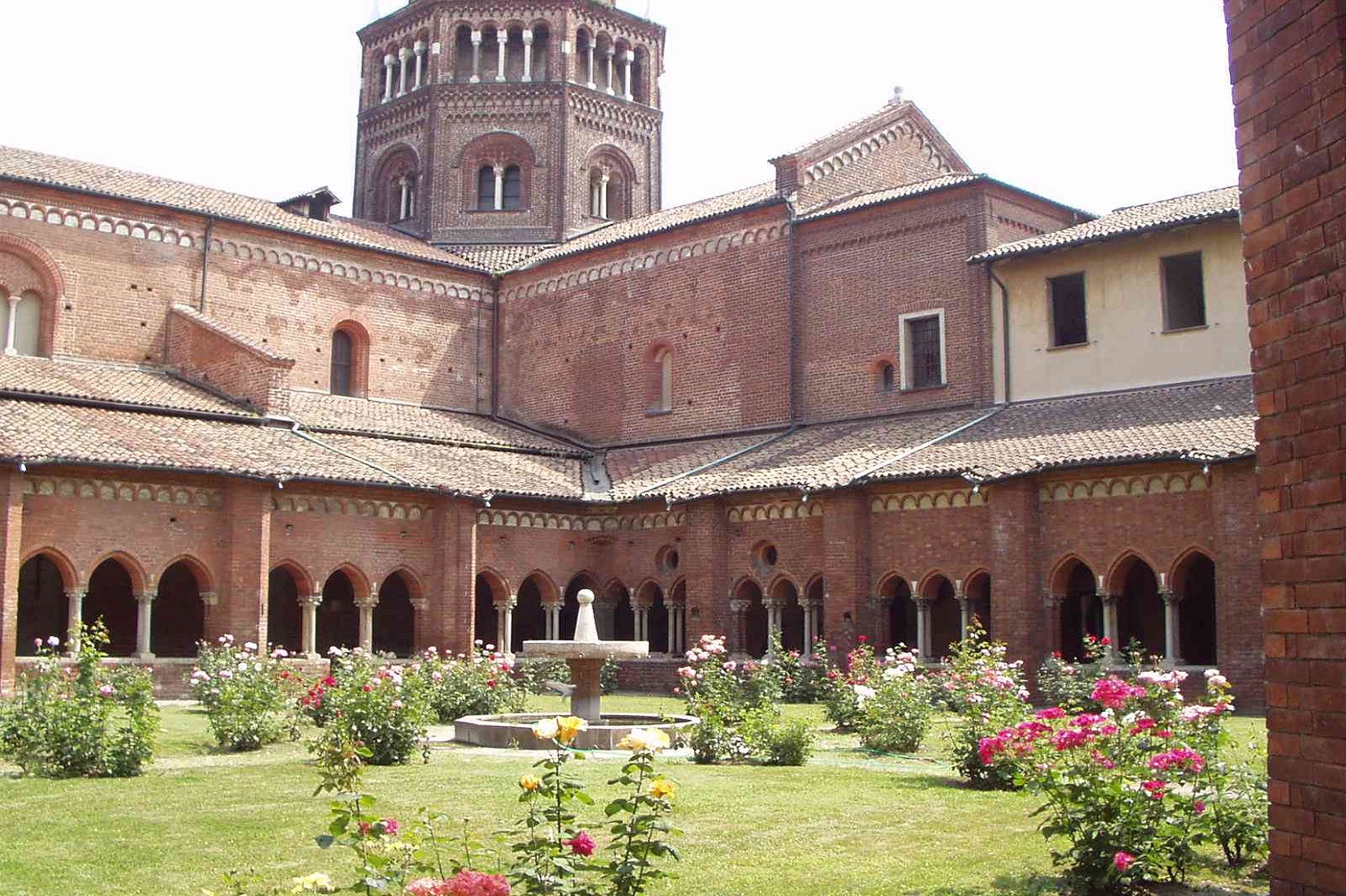South of Milan, just a few hundred meters from the city, you are immediately immersed in the fields between farmhouses, canals and rice fields. In this rural setting there are seven places of faith and prayer, centres of monastic communities that played a fundamental role in the agricultural and cultural development of the Milanese countryside: the Cistercian monks reclaimed the marshy and unhealthy lands that surrounded Milan, harnessing the waters in irrigation canals and turning marshes into water meadows to make land fertile.
Since 1990 this territory is part of the South Milan Agricultural Park. The Road of the Abbeys crosses a large part of the park and connects seven masterpieces of medieval art.
Here we will focus on the unmissable stages of this path, for which we have verified accessibility.
Chiaravalle Abbey
In the ancient agricultural village of Chiaravalle Milanese rises the abbey complex famous for its tower, called "Ciribiciaccola". Built according to the Cistercian rules starting from 1135 by the will of Bernardo di Chiaravalle, the abbey certainly deserves a visit to the various and evocative spaces, starting with the church. In fact, between the 16th and the 18th centuries, important artists of the Milan area, such as Bernardino Luini and the Fiammenghini brothers, contributed to its decorations. The seventeenth-century wooden choir is wonderful, and it is still used today by monks who seat there during the religious services. From inside the church you can access the Cloister with its elegant columns, among which the curious bundle of knotted columns stands out.
At the entrance of the abbey complex, on the left, there is a small and charming fifteenth century chapel dedicated to St. Bernard and called "the chapel of women", because according to the Benedictine rule, women could not go to the abbey church except on the day of the feast of the Dedication.
In 2009 the ancient mill of Chiaravalle was reopened to the public; it is adjacent to the abbey, with its typically medieval structure, spread over two floors and outside there is a garden of aromatic plants.
Here you can find information on the accessibility of the Abbey and of the ancient mill
The tireless work of the monks of Chiaravalle, starting from the medieval period up to the modern period in the reclamation and cultivation of previously unhealthy and swampy territories, can be seen even today in the production of honey, jams, sauces and salts and in the direct management of the cattle in their farmhouse. From 2017 then, the monks opened a Cafeteria, a resting place inside the Abbey courtyard,
Here you can find all the information on guided tours.
Facebook Page
Viboldone Abbey
Founded by the humiliated monks in the 12th century and completed nearly two centuries later, thanks to the beauty of its terracotta architecture and its fourteenth-century frescoes, it is one of the most important medieval complexes in Lombardy. Among its paintings, the most ancient work is the lunette above the arch of access to the apse area, depicting the Virgin Mary and Child enthroned between the archangel Michael, a donor and saints, dating back to 1349.
For further information on the church, please click here
In addition, it is possible to use fixed audio guides available in Italian, English, French and Russian.
Today in the Abbey live the cloistered nuns of the Order of St. Benedict who follow, like the monks in Chiaravalle, the rule of the "Ora et labora". The nuns carry out various manual works: an ancient book restoration workshop that has been operating for more than 40 years, a digital printing sector, bookbinding and icon writing activities on wood, wax, parchment. The monastery offers hospitality in its own guesthouse, which has rooms and some meeting rooms for groups and offers, in addition to moments of prayer, study meetings on biblical, historical, spiritual and ecumenical content. To find out more, please consult the site of the Abbey
Here you can find information on the accessibility of the Abbey of Viboldone.
Abbey of Morimondo,
The abbey of Morimondo is one of the most important Cistercian complexes of 1200. Its construction was anything but easy: because of the repeated looting and raids by troops from Milan and Pavia, in the never ending clashes between the two cities for supremacy, it took more than a century for the monks to succeed in accomplishing their job. Today the abbey looks like a grandiose and elegant building in clay bricks, produced by the furnace that the monks built for this purpose. In an area where there were no quarries, in fact, the use of clay was fundamental both for the ease of finding and processing, and because it reflected the choice of monastic poverty. For Morimondo, as for all the Cistercian abbeys, beauty does not derive from decorations or from the use of precious materials, but from the functionality and essentiality of the elements, from geometric ratios, and from the way natural light illuminates spaces and from optimal acoustics. Thanks to its excellent acoustics every year, on several occasions, Morimondo hosts concerts of classical and sacred music and performances of choral songs.
During a visit to the Abbey, which largely preserves its medieval structure, you can admire the Cloister, the Chapter Room, the Monks' Working Rooms, the Hall of Founders, the Loggia, the Refectory, the Dormitory and the adjacent Comolli Museum, which preserves preparatory works and sketches of the painter and Art Nouveau fresco maker Comolli.
Here you can find more information for visiting the abbey
The abbey is located in a limited traffic area, but access is free every day for disabled pass holder and every Sunday in order to take part to the Mass. Here you can find information on accessibility.
San Pietro in Gessate
In the centre of Milan, opposite the Palazzo di Giustizia and a few hundred meters from the Duomo, stands the church of San Pietro in Gessate, a refined example of a Lombard church dating back to 1400. In 1493 the church became an abbey. Despite being heavily damaged by bombs during World War II, it still preserves precious examples of the Lombard paintings of the late 1400s, including the wonderful stories of Sant'Ambrogio in the Grifi Chapel, by Bernardino Butinone and Bernardo Zenale. A fresco by Ambrogio Bergognone, depicting the Funeral of San Martino, and a Virgin with the Child of Leonardesque school date back to 1514. San Pietro is worth a visit both for the essential beauty of its architecture and its works of art, and for its history; in the years, in fact, some of its spaces changed the intended original use. Following the suppression of the monastic orders commissioned by Maria Theresa of Austria starting from 1770, in fact, the convent had been destined to host the orphan boys of Milan, called Martinitt, who could live in the rooms of San Pietro in Gessate until 18 years old and learn a job for their future. Napoleon moved them to Brera and transformed the convent into a military hospital, deteriorating some of what was later badly ruined by the bombings of 1943. Once the church had a cloister, now rebuilt and incorporated into the structure of the adjacent scientific High School.
Here you can find information on accessibility.
Before leaving
At this link you can download the map of the Road of the Abbeys and get detailed information about the whole route.
At this link you can download maps and information about cycling routes.
For more information on the various stages of the Road of the Abbeys please visit the Valle dei Monaci website: www.valledeimonaci.org
"Project carried out under the General program of intervention of the Lombardy Region, funded by the Ministry of Economic Development - 2015 Allocation".

